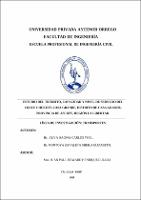Mostrar el registro sencillo del ítem
Estudio del tránsito, capacidad y nivel de servicio del cruce Chocope - Casa Grande, distrito de Casa Grande, provincia de Ascope, región La Libertad
| dc.contributor.advisor | Henriquez Ulloa, Juan Paul Edward | |
| dc.contributor.author | Alva Saona, Carlos Yoel | |
| dc.contributor.author | Montoya Zavaleta, Sheila Elizabeth | |
| dc.creator | Alva Saona, Carlos Yoel | |
| dc.date.accessioned | 2019-10-21T14:15:34Z | |
| dc.date.available | 2019-10-21T14:15:34Z | |
| dc.date.issued | 2019 | |
| dc.identifier.uri | https://hdl.handle.net/20.500.12759/5546 | |
| dc.description.abstract | El crecimiento del parque automotor es a nivel mundial, generando así cada vez más tráfico vehicular, como en la región La Libertad donde se nos hizo necesario afrontar esta realidad, que conlleva al congestionamiento vehicular y al bajo nivel de servicio de las vías en zonas urbanas y rurales. Nosotros como ingenieros civiles debemos proporcionar soluciones ante esta problemática, diseñando y creando proyectos que nos brinden una óptima red vial. En base a esta problemática surgió nuestra tesis, donde aplicamos los estándares del Manual de Capacidad de Carreteras (“Highway Capacity Manual, HCM”), las normas del Ministerio de Transportes y Comunicaciones (MTC). Ello fue guía fundamental para el desarrollo de nuestra tesis, pues siguiendo las pautas e indicaciones pudimos realizar un estudio limpio y ordenado en la investigación, permitiéndonos dar solución a las condiciones de transpirabilidad existentes en la zona analizada. Finalmente obtuvimos nuestras conclusiones como implementar las señales de tránsito verticales e horizontales y recomendaciones de realizar un estudio con conteos de 24 horas en un periodo semanal, para fines de pavimentación y realizar estudios de flujos con modelos estadísticos; dejando así un presente útil para estudios a futuro. | es_PE |
| dc.description.abstract | The growth of the automotive fleet is worldwide, thus generating more and more vehicular traffic, as in the La Libertad region where we were faced with this reality, which leads to vehicular congestion and the low level of road service in urban areas and rural. We as civil engineers must provide solutions to this problem, designing and creating projects that provide us with an optimal road network. Based on this problem, our thesis emerged, where we apply the standards of the Highway Capacity Manual (HCM), the standards of the Ministry of Transportation and Communications (MTC). This was a fundamental guide for the development of our thesis, because following the guidelines and indications we were able to carry out a clean and orderly study in the investigation, allowing us to solve the passability conditions existing in the analyzed area. Finally we obtained our conclusions such as implementing vertical and horizontal traffic signals and recommendations to conduct a study with 24-hour counts in a weekly period, for paving purposes and to conduct flow studies with statistical models; leaving a useful present for future studies. | en_US |
| dc.description.uri | Tesis | es_PE |
| dc.format | application/pdf | es_PE |
| dc.language.iso | spa | es_PE |
| dc.publisher | Universidad Privada Antenor Orrego | es_PE |
| dc.relation.ispartofseries | T_ING.CIVIL_1780 | |
| dc.rights | info:eu-repo/semantics/closedAccess | es_PE |
| dc.rights.uri | https://creativecommons.org/licenses/by/4.0/ | es_PE |
| dc.source | Universidad Privada Antenor Orrego | es_PE |
| dc.source | Repositorio Institucional - UPAO | es_PE |
| dc.subject | Tránsito | es_PE |
| dc.subject | Cruce | es_PE |
| dc.title | Estudio del tránsito, capacidad y nivel de servicio del cruce Chocope - Casa Grande, distrito de Casa Grande, provincia de Ascope, región La Libertad | es_PE |
| dc.type | info:eu-repo/semantics/bachelorThesis | es_PE |
| thesis.degree.level | Título Profesional | es_PE |
| thesis.degree.grantor | Universidad Privada Antenor Orrego. Facultad de Ingeniería | es_PE |
| thesis.degree.name | Ingeniero Civil | es_PE |
| thesis.degree.discipline | Ingeniería Civil | es_PE |
| dc.subject.ocde | https://purl.org/pe-repo/ocde/ford#2.01.00 | |
| renati.type | https://purl.org/pe-repo/renati/type#tesis | |
| renati.level | https://purl.org/pe-repo/renati/level#tituloProfesional | |
| dc.publisher.country | PE | es_PE |
Ficheros en el ítem
Este ítem aparece en la(s) siguiente(s) colección(es)
-
Ingeniería Civil [1260]


